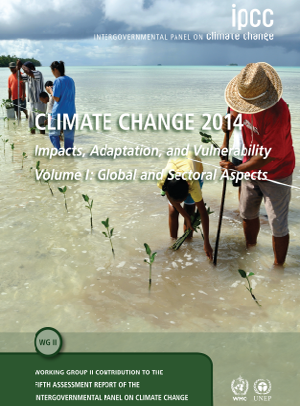
By Anne Waple, Second Nature
IPCC reports progress on responding to climate change, but much more action needed to reduce risk
This week, the Intergovernmental Panel on Climate Change released the second in a three-part global climate assessment. The report, Climate Change 2014: Impacts, Adaptation, and Vulnerability, was written by 309 Coordinating Lead Authors from 70 countries, an additional 436 contributing authors, and was reviewed by over 1700 experts. The report looks at the nature of changing climate risk and the opportunities to increase resilience in a changing climate.
The report is certainly the most comprehensive global report of its kind and represents the current state of consensus understanding on impacts and responses related to climate change. This report also sets the stage for the release of the Third U.S. National Climate Assessment, due to hit the streets in late April/early May. That assessment will take a closer look at climate changes, impacts, and responses at the scale of the U.S. (watch this space for more on that soon as well as an overview of several recent and upcoming reports and how to use them!).
The IPCC adaptation report comes in 2 volumes (global and regional) and contains synthesized knowledge from over 12,000 publications. Many of the chapters will make for very important reading and educational material across higher education and for our partners and communities, but if you’d like to get a more digestible summary of the content, the report’s ‘Summary for Policymakers’ highlights the key findings. Some of the key conclusions include:
“Impacts from recent climate-related extremes, such as heat waves, droughts, floods, cyclones, and wildfires, reveal significant vulnerability and exposure of some ecosystems and many human systems to current climate variability”.And the report goes on to say that ‘For countries at all levels of development, these impacts are consistent with a significant lack of preparedness for current climate variability in some sectors”. It is important to note that we are not particularly well-adapted even to extremes in our current climate and therefore this demonstrates the degree of planning and implementation that will be needed to cope with impacts from increasing changes.
“Adaptation is becoming embedded in some planning processes, with more limited implementation of responses”.The report also notes, that “Most assessments of adaptation have been restricted to impacts, vulnerability, and adaptation planning, with very few assessing the processes of implementation or the effects of adaptation actions”
“Adaptation and mitigation choices in the near-term will affect the risks of climate change throughout the 21st century”.What this means of course, is that the more mitigation (e.g. carbon emissions reduction) we do in the near term, the less adaptation we have to do in the long term if we want to reduce our risk. This is particularly important where the increased risk would exceed our capacity to adapt. The IPCC captures this further by stating that “Increasing magnitudes of warming increase the likelihood of severe, pervasive, and irreversible impacts”, and “The overall risks of climate change impacts can be reduced by limiting the rate and magnitude of change”
Mitigating global climate change will be the subject of the next IPCC report, due out in April, but the important note is that a combined approach for an effective climate response is necessary. It is also clear from the findings that while climate-related planning and implementation is gaining momentum, most of us will still face significant risks from climate change.
Of course, at Second Nature, we take the stance that higher education has a huge and critical role to play in leading progress on both mitigation and adaptation. While the 680 institutions of the American Colleges and University Presidents’ Climate Commitment have achieved over 25% reduction in emissions across the network, Second Nature is also shortly to announce the Alliance for Resilient Campuses and we hope to illustrate that progress on both fronts is not only necessary, but possible, and transformative, especially when we demonstrate clear leadership and learn and act collectively.

Add new comment